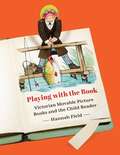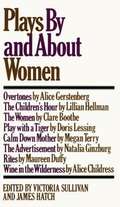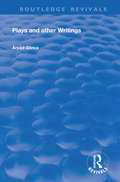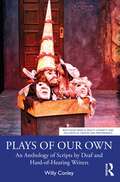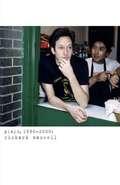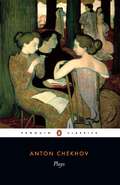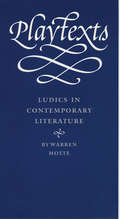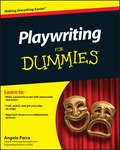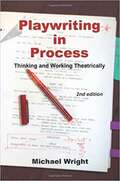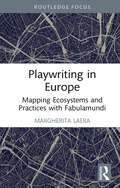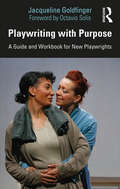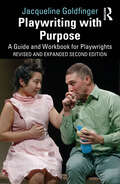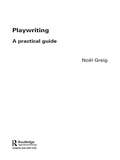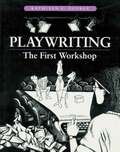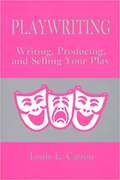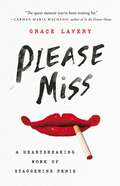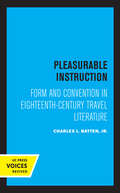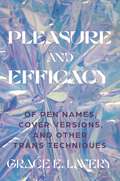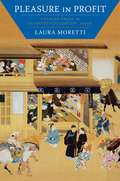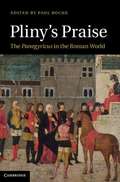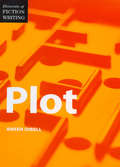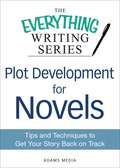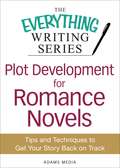- Table View
- List View
Playing with the Book: Victorian Movable Picture Books and the Child Reader
by Hannah FieldA beautifully illustrated exploration of how Victorian novelty picture books reshape the ways children read and interact with texts The Victorian era saw an explosion of novelty picture books with flaps to lift and tabs to pull, pages that could fold out, pop-up scenes, and even mechanical toys mounted on pages. Analyzing books for young children published between 1835 and 1914, Playing with the Book studies how these elaborately designed works raise questions not just about what books should look like but also about what reading is, particularly in relation to children&’s literature and child readers. Novelty books promised (or threatened) to make reading a physical as well as intellectual activity, requiring the child to pull a tab or lift a flap to continue the story. These books changed the relationship between pictures, words, and format in both productive and troubling ways. Hannah Field considers these aspects of children&’s reading through case studies of different formats of novelty and movable books and intensive examination of editions that have survived from the nineteenth century. She discovers that children ripped, tore, and colored in their novelty books—despite these books&’ explicit instructions against such behaviors.Richly illustrated with images of these ingenious constructions, Playing with the Book argues that novelty books construct a process of reading that involves touch as well as sight, thus reconfiguring our understanding of the phenomenology of reading.
Plays By and About Women
by James Hatch Victoria SullivanEight plays, all written in this century, in which leading women dramatists present their own pictures of their sex.
Plays and Other Writings (Routledge Revivals)
by Arpad GonczOriginally published in 1990, this volume is a full translation from Hungarian of Men of God; 1944; The Front; Homecoming; Old People; The Child; Balance; Power; Encounter; and Persephone: Play in Two Acts.
Plays of Our Own: An Anthology of Scripts by Deaf and Hard-of-Hearing Writers (Routledge Series in Equity, Diversity, and Inclusion in Theatre and Performance)
by Willy ConleyPlays of Our Own is the first anthology of its kind containing an eclectic range of plays by Deaf and hard-of-hearing writers. These writers have made major, positive contributions to world drama or Deaf theatre arts. Their topics range from those completely unrelated to deafness to those with strong Deaf-related themes such as a dreamy, headstrong girl surviving a male-dominated world in Depression-era Ireland; a famous Spanish artist losing his hearing while creating his most controversial art; a Deaf African-American woman dealing with AIDS in her family; and a Deaf peddler ridiculed and rejected by his own kind for selling ABC fingerspelling cards. The plays are varied in style – a Kabuki western, an ensemble-created variety show, a visual-gestural play with no spoken nor signed language, a cartoon tragicomedy, historical and domestic dramas, and a situation comedy. This volume contains the well-known Deaf theatre classics, My Third Eye and A Play of Our Own. At long last, directors, producers, Deaf and hearing students, professors, and researchers will be able to pick up a book of "Deaf plays" for production consideration, Deaf culture or multicultural analysis, or the simple pleasure of reading.
Plays, 1996-2000 (Maxwell)
by Richard MaxwellThis volume collects for the first time the work of one of America's most important, vital and original young voices. Turning the American family drama firmly on its head, "Maxwell strips more layers of explanation from the Freudian family romance, shining light on the humiliation and fury usually reasoned out of sight by psychologizing playwrights. Few characters in contemporary drama are as exposed as Maxwell's."--Marc Robinson, Village Voice"Imagine if you took a giant hatpin and stuck it into Sylvester Stallone's Rocky. Once all the hot air had leaked out of that melodrama about a working-class underdog who wins fame, fortune and love in the boxing ring, you might find something very much like Richard Maxwell's Boxing 2000. By taking a conventional formula and draining it of all its humid sentimentality and synthetic adrenaline, Mr. Maxwell discovers something new and unexpected. Boxing 2000 is a real knockout: a play that not only challenges theatrical clichés, but your ideas about theatre itself."--Wall Street Journal""It's a sensation that's felt all too rarely these days. Watching Mr. Maxwell's work makes you think of what it must have been like to stumble upon the baffling but seductive creations of a young Sam Shepard in the early 1960's in the East Village."--, New York TimesThis first volume collects nine of Maxwell's early works: Boxing 2000, Caveman, House (1999 OBIE Award winner), Showy Lady Slipper and others.Richard Maxwell is a writer, director and songwriter. He began his acting career with the Steppenwolf Theatre Company in Chicago, where he helped found the Cook County Theater Department, which challenged the principles of traditional acting training. He is artistic director of New York City Players. His plays have been performed in the U.S. at Soho Rep, The Kitchen, P.S. 122, HERE, the Williamstown Theater Festival, Walker Arts Center and the Wexner Center for the Arts; and in Paris, Berlin, Dublin, Brussels, Amsterdam and Vienna.
Plays: The Seagull [and] The Cherry Orchard
by Anton ChekhovAt a time when the Russian theatre was dominated by formulaic melodramas and farces, Chekhov created a new sort of drama that laid bare the everyday lives, loves and yearnings of ordinary people. Ivanov depicts a man stifled by inactivity and lost idealism, and The Seagull contrasts a young man's selfish romanticism with the stoicism of a woman cruelly abandoned by her lover. With 'the scenes from country life' of Uncle Vanya, his first fully mature play, Chekhov developed his own unique dramatic world, neither tragedy nor comedy. In Three Sisters the Prozorov sisters endlessly dream of going to Moscow to escape the monotony of provincial life, while his comedy The Cherry Orchard portrays characters futilely clinging to the past as their land is sold from underneath them.
Playtexts: Ludics in Contemporary Literature (Stages)
by Warren Motte Jr.“Not hubris but the ever self-renewing impulse to play calls new worlds into being.”—Nietzsche Parents and politicians have always taken play seriously. Its formative powers, its focus, its energy, and its ability to signify other things have drawn the attention of writers from Plato and Schiller to Wittgenstein, Nabokov, and Eco. The ease with which an election becomes perceived as a race, a political crisis as a football game, or an argument as a tennis match readily proves how much play means to contemporary life. Just how play confers meaning, however, is best revealed in literature, where meaning is perpetually at stake. “At stake” itself, the risk of a gamble, is only one intersection between play and life. Playtexts reveals numerous junctures where literary playfulness—seemingly so diverting and irrelevant—instead opens the most profound questions about creativity, community, value, and belief. How do authors play with their words and readers? Can literature proceed at all unless a reader is willing and able to play? No moralizing monologue, Playtexts is all for exuberance and creative surge: Breton’s construction of an antinovel, Gombrowicz’s struggle with adult formalities, Nabokov’s swats at the humorless, Sarrazin’s seductive notes, Eco’s recasting of spy and detective fiction, Reyes’s carnal metaphorics.
Playwriting For Dummies
by Angelo ParraThe easy way to craft, polish, and get your play on stage Getting a play written and produced is a daunting process. From crystallizing story ideas, formatting the script, understanding the roles of the director stagecraft people, to marketing and financing your project, and incorporating professional insights on writing, there are plenty of ins and outs that every aspiring playwright needs to know. But where can you turn for guidance? Playwriting For Dummies helps any writer at any stage of the process hone their craft and create the most dramatic and effective pieces. Guides you through every process of playwriting?from soliloquies, church skits, and one act plays to big Broadway musicals Advice on moving your script to the public stage Guidance on navigating loopholes If you're an aspiring playwright looking to begin the process, or have already penned a masterpiece and need trusted advice to bring it into the spotlight, Playwriting For Dummies has you covered.
Playwriting In Process: Thinking And Working Theatrically
by Michael WrightPlaywriting in Process: Thinking and Working Theatrically is written to encourage new and experienced playwrights to build techniques for a greater range of creative expression in writing for the stage. The book uses exercises to guide playwrights towards thinking and working theatrically. The exercises help playwrights start or revise their work by providing alternate ways of thinking about their subject and their processes. New to the second edition: new exercises, a general updating such as the use of the internet, a new chapter for teachers and playwriting group leaders on using this book in class, and end-of-chapter "Call Out" exercises. Useful for playwrights at all levels.
Playwriting Playgoers in Shakespeare's Theater
by Matteo A. PangalloAmong the dramatists who wrote for the professional playhouses of early modern London was a small group of writers who were neither members of the commercial theater industry writing to make a living nor aristocratic amateurs dipping their toes in theatrical waters for social or political prestige. Instead, they were largely working- and middle-class amateurs who had learned most of what they knew about drama from being members of the audience.Using a range of familiar and lesser-known print and manuscript plays, as well as literary accounts and documentary evidence, Playwriting Playgoers in Shakespeare's Theater shows how these playgoers wrote and revised to address what they assumed to be the needs of actors, readers, and the Master of the Revels; how they understood playhouse materials and practices; and how they crafted poetry for theatrical effects. The book also situates them in the context of the period's concepts of, and attitudes toward, playgoers' participation in the activity of playmaking.Plays by playgoers such as the rogue East India Company clerk Walter Mountfort or the highwayman John Clavell invite us into the creative imaginations of spectators, revealing what certain audience members wanted to see and how they thought actors might stage it. By reading Shakespeare's theater through these playgoers' works, Matteo Pangallo contributes a new category of evidence to our understanding of the relationships between the early modern stage, its plays, and its audiences. More broadly, he shows how the rise of England's first commercialized culture industry also gave rise to the first generation of participatory consumers and their attempts to engage with mainstream culture by writing early modern "fan fiction."
Playwriting in Europe: Mapping Ecosystems and Practices with Fabulamundi (Routledge Advances in Theatre & Performance Studies)
by Margherita LaeraThis book maps contemporary playwriting and theatre translation practices and ecologies in the European continent. Whether you are a scholar researching contemporary drama and translation, or a theatre practitioner looking for ways to navigate theatrical conventions in other countries, this book is for you. Through questionnaires and one-to-one interviews with key stakeholders, Dr Laera collects qualitative and quantitative data about how each national theatre culture supports living dramatists, what conventions drive the production and translation (or lack thereof) of contemporary plays, and what perceptions are held by gatekeepers, theatre-makers and other cultural operators about the theatre system in which they work. Through country-by-country descriptions and analyses; interviews with playwrights, translators, directors and gatekeepers; a list of key facts and best practices; and a rigorous assessment of its methodologies, this volume is indispensable for those interested in contemporary European theatre practice.
Playwriting with Purpose: A Guide and Workbook for New Playwrights
by Jacqueline GoldfingerPlaywriting with Purpose: A Guide and Workbook for New Playwrights provides a holistic approach to playwriting from an award-winning playwright and instructor. This book incorporates craft lessons by contemporary playwrights and provides concrete guidance for new and emerging playwrights. The author takes readers through the entire creative process, from creating characters and writing dialogue and silent moments to analyzing elements of well-made plays and creating an atmospheric environment. Each chapter is followed by writing prompts and pro tips that address unique facets of the conversation about the art and craft of playwriting. The book also includes information on the business of playwriting and a recommended reading list of published classic and contemporary plays, providing all the tools to successfully transform an idea into a script, and a script into a performance. Playwriting with Purpose gives writers and students of playwriting hands-on lessons, artistic concepts, and business savvy to succeed in today’s theater industry.
Playwriting with Purpose: A Guide and Workbook for Playwrights
by Jacqueline GoldfingerPlaywriting with Purpose: A Guide and Workbook for New Playwrights, Second Edition provides a revised and greatly expanded holistic approach to playwriting from an award-winning playwright and professor.This book incorporates craft lessons, scenes for study, and concrete guidance in both the art and business of playwriting. The author takes readers through the entire creative process, from creating characters and writing dialogue to revising and producing your play. Each chapter includes incisive craft lessons, provocative writing prompts, examples from plays, tips from working artists, reading recommendations, and more. Thoroughly revised, new features to this edition include: Vastly expanded sections on structure, world building, business of playwriting, writing for television and film, and more New writing exercises and pro tips from working playwrights in each chapter An exploration of art and craft through a new selection of international plays Shorter chapters with more subject headings to make it easier to find the exact craft lesson or writing prompt you want when you want it Playwriting with Purpose gives writers and students the tools to succeed in today’s theater industry.
Playwriting: A Practical Guide
by Noël GreigPlaywriting offers a practical guide to the creation of text for live performance. It contains a wealth of exercises for amateur and professional playwrights. Usable in a range of contexts, the book works as: a step-by-step guide to the creation of an individual play a handy resource for a teacher or workshop leader a stimulus for the group-devised play. The result of Noël Greig's thirty years' experience as a playwright, actor, director and teacher, Playwriting is the ideal handbook for anyone who engages with playwriting and is ultimately concerned with creating a story and bringing it to life on the stage.
Playwriting: The First Workshop
by Kathleen E. GeorgeThis is a practical introduction to the basic principles, structures and processes of writing plays. Beginning with simple concepts and exercises, this book gradually builds in complexity, until the reader is writing his or her one act play. Writing plays is unique because feedback, alternative approaches and discussion spur creativity. This book encourages this and thereby encourages the reader to write. The reader will discover how stage plays differ from screenplays, novels and television. The book also describes how autobiographical materials are transformed into playable parts, and how characters are moved by action. `Playwriting: The first workshop' gives readers the necessary background to begin working on their first play. Captures the workshop experience through writing, analyzing and testing plays. Contains synopsis and analysis of several well-known plays, such as `The Dining Room'. Each chapter provides study questions and exercises that reinforce important concepts.
Playwriting: Writing, Producing And Selling Your Play
by Louis E. CatronA practical guidebook for effective playwriting! This imaginative and enthusiastic book is designed especially for those having the desire to create, to entertain, and to express their emotions and ideas. It features a practical, down-to-earth emphasis on craft and structure rather than on theory as its step-by-step approach shows just what’s involved in creating a stageworthy play. Coverage includes basic considerations such as plot and character development, theme and dialogue as well as production and publication considerations. Outstanding features: offers concrete writing guidelines; includes exercises that get the reader going and inspirational anecdotes; presents excerpts from such classics as Macbeth, The Glass Menagerie, and The Dumb Waiter that help the student grasp key concepts; lists plays to read for instruction; includes valuable information not usually found in comparable collections.
Please Miss: A Heartbreaking Work of Staggering Penis
by Grace Lavery&“The queer memoir you&’ve been waiting for&”—Carmen Maria MachadoGrace Lavery is a reformed druggie, an unreformed omnisexual chaos Muppet, and 100 percent, all-natural, synthetic female hormone monster. As soon as she solves her &“penis problem,&” she begins receiving anonymous letters, seemingly sent by a cult of sinister clowns, and sets out on a magical mystery tour to find the source of these surreal missives. Misadventures abound: Grace performs in a David Lynch remake of Sunset Boulevard and is reprogrammed as a sixties femmebot; she writes a Juggalo Ghostbusters prequel and a socialist manifesto disguised as a porn parody of a quiz show. Or is it vice versa? As Grace fumbles toward a new trans identity, she tries on dozens of different voices, creating a coat of many colors.With more dick jokes than a transsexual should be able to pull off, Please Miss gives us what we came for, then slaps us in the face and orders us to come again.
Pleasurable Instruction: Form and Convention in Eighteenth-Century Travel Literature
by Charles L BattenThis title is part of UC Press's Voices Revived program, which commemorates University of California Press’s mission to seek out and cultivate the brightest minds and give them voice, reach, and impact. Drawing on a backlist dating to 1893, Voices Revived makes high-quality, peer-reviewed scholarship accessible once again using print-on-demand technology. This title was originally published in 1978.
Pleasure Dome: New and Collected Poems (Wesleyan Poetry Series)
by Yusef KomunyakaaYusef Komunyakaa has become one of America's most compelling poets. Pleasure Dome gathers over twenty-five years of work, including early uncollected poems and a rich selection of new poems. Best known for Neon Vernacular, which won the Pulitzer Prize for Poetry in 1994, and for Dien Cai Dau, a collection of poems chronicling his experiences as a journalist in Vietnam, Yusef Komunyakaa has become one of America's most compelling poets. Pleasure Dome gathers the poems in these two distinguished books and five others—over two and a half decades of Komunyakaa's work. In addition, Pleasure Dome includes 25 early, uncollected poems and a rich selection of 18 new poems.
Pleasure and Efficacy: Of Pen Names, Cover Versions, and Other Trans Techniques
by Grace Elisabeth LaveryA leading trans scholar and activist explores cultural representations of gender transition in the modern periodIn Pleasure and Efficacy, Grace Lavery investigates gender transition as it has been experienced and represented in the modern period. Considering examples that range from the novels of George Eliot to the psychoanalytic practice of Sigmund Freud to marriage manuals by Marie Stopes, Lavery explores the skepticism found in such works about whether it is truly possible to change one’s sex. This ambivalence, she argues, has contributed to both antitrans oppression and the civil rights claims with which trans people have confronted it. Lavery examines what she terms “trans pragmatism”—the ways that trans people resist medicalization and pathologization to achieve pleasure and freedom. Trans pragmatism, she writes, affirms that transition works, that it is possible, and that it happens.With Eliot and Freud as the guiding geniuses of the book, Lavery covers a vast range of modern culture—poetry, prose, criticism, philosophy, fiction, cinema, pop music, pornography, and memes. Since transition takes people out of one genre and deposits them in another, she suggests, it should be no surprise that a cultural history of gender transition will also provide, by accident, a history of genre transition. Considering the concept of technique and its associations with feminine craftiness, as opposed to masculine freedom, Lavery argues that techniques of giving and receiving pleasure are essential to the possibility of trans feminist thriving—even as they are suppressed by patriarchal and antitrans feminist philosophies. Contesting claims for the impossibility of transition, she offers a counterhistory of tricks and techniques, passed on by women to women, that comprises a body of knowledge written in the margins of history.
Pleasure in Profit: Popular Prose in Seventeenth-Century Japan
by Laura MorettiIn the seventeenth century, Japanese popular prose flourished as waves of newly literate readers gained access to the printed word. Commercial publishers released vast numbers of titles in response to readers’ hunger for books that promised them potent knowledge. However, traditional literary histories of this period position the writings of Ihara Saikaku at center stage, largely neglecting the breadth of popular prose.In the first comprehensive study of the birth of Japanese commercial publishing, Laura Moretti investigates the vibrant world of vernacular popular literature. She marshals new data on the magnitude of the seventeenth-century publishing business and highlights the diversity and porosity of its publishing genres. Moretti explores how booksellers sparked interest among readers across the spectrum of literacies and demonstrates how they tantalized consumers with vital ethical, religious, societal, and interpersonal knowledge. She recasts books as tools for knowledge making, arguing that popular prose engaged its audience cognitively as well as aesthetically and emotionally to satisfy a burgeoning curiosity about the world. Crucially, Moretti shows, readers experienced entertainment within the didactic, finding pleasure in the profit gained from acquiring knowledge by interacting with transformative literature. Drawing on a rich variety of archival materials to present a vivid portrait of seventeenth-century Japanese publishing, Pleasure in Profit also speaks to broader conversations about the category of the literary by offering a new view of popular prose that celebrates plurality.
Pliny's Praise
by Paul RochePliny's Panegyricus (AD 100) survives as a unique example of senatorial rhetoric from the early Roman Empire. It offers an eyewitness account of the last years of Domitian's principate, the reign of Nerva and Trajan's early years, and it communicates a detailed senatorial view on the behaviour expected of an emperor. It is an important document in the development of the ideals of imperial leadership, but it also contributes greatly to our understanding of imperial political culture more generally. This volume, the first ever devoted to the Panegyricus, contains expert studies of its key historical and rhetorical contexts, as well as important critical approaches to the published version of the speech and its influence in antiquity. It offers scholars of Roman history, literature and rhetoric an up-to-date overview of key approaches to the speech, and students and interested readers an authoritative introduction to this vital and under-appreciated speech.
Plot (Elements of Fiction Writing)
by Ansen Dibell"There are ways to create, fix, steer and discover plots - ways which, over a writing life, you'd eventually puzzle out for yourself," writes Ansen Dibell. "They aren't laws. They're an array of choices, things to try, once you've put a name to the particular problem you're facing now. " That's what this book is about: identifying those choices (whose viewpoint? stop and explain now, or wait? how can this lead to that?), then learning what narrative problems they are apt to create and how to choose an effective strategy for solving them. The result? Strong, solid stories and novels that move. Inside you'll discover how to: test a story idea (using four simple questions) to see if it works convince your reader that not only is something happening, but that something's going to happen and it all matters intensely handle viewpoint shifts, flashbacks, and other radical jumps in your storyline weave plots with subplots get ready for and write your Big Scenes balance scene and summary narration to produce good pacing handle the extremes of melodrama by "faking out" your readers - making them watch your right hand while your left hand is doing something sneaky form subtle patterns with mirror characters and echoing incidents choose the best type of ending - linear or circular, happy or downbeat, or (with caution!) a trick ending Whether your fiction is short or long, subtle or direct, you'll learn to build strong plots that drive compelling, unforgettable stories your readers will love.
Plot Development for Novels: Tips and Techniques to Get Your Story Back on Track (The Everything® Writing Series)
by Adams MediaHave you run into writer’s block? Not sure of the next twist or turn for your novel? Beat your block and keep things interesting with The Everything® Writing Series: Plot Development for Novels. You’ll be able to get your story back on track with these helpful tips and ideas. With some quick reading, you’ll be back to writing in no time.
Plot Development for Romance Novels: Tips and Techniques to Get Your Story Back on Track (The Everything® Writing Series)
by Adams MediaHave you run into writer’s block? Not sure how to plot the next twist in your romance? Beat your block and keep things dramatic with The Everything® Writing Series: Plot Development for Romance Novels. You’ll be able to get your story back on track with these helpful tips and ideas. With some quick reading, you’ll be back to writing in no time.
